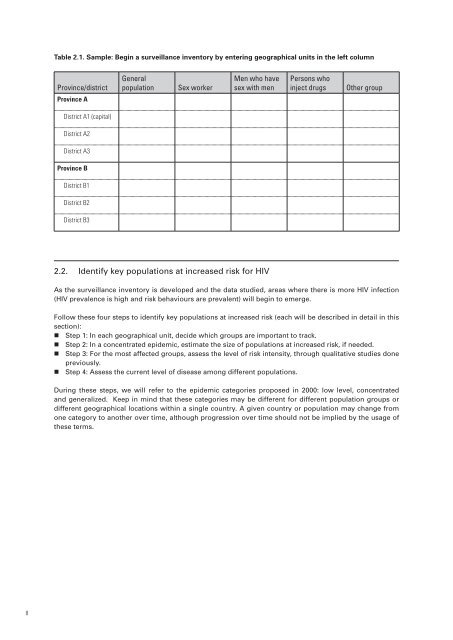Guidelines for second generation HIV surveillance - World Health ...
Guidelines for second generation HIV surveillance - World Health ...
Guidelines for second generation HIV surveillance - World Health ...
Create successful ePaper yourself
Turn your PDF publications into a flip-book with our unique Google optimized e-Paper software.
Table 2.1. Sample: Begin a <strong>surveillance</strong> inventory by entering geographical units in the left column<br />
Province/district<br />
Province A<br />
General<br />
population<br />
Sex worker<br />
Men who have<br />
sex with men<br />
Persons who<br />
inject drugs<br />
Other group<br />
District A1 (capital)<br />
District A2<br />
District A3<br />
Province B<br />
District B1<br />
District B2<br />
District B3<br />
2.2. Identify key populations at increased risk <strong>for</strong> <strong>HIV</strong><br />
As the <strong>surveillance</strong> inventory is developed and the data studied, areas where there is more <strong>HIV</strong> infection<br />
(<strong>HIV</strong> prevalence is high and risk behaviours are prevalent) will begin to emerge.<br />
Follow these four steps to identify key populations at increased risk (each will be described in detail in this<br />
section):<br />
• Step 1: In each geographical unit, decide which groups are important to track.<br />
• Step 2: In a concentrated epidemic, estimate the size of populations at increased risk, if needed.<br />
• Step 3: For the most affected groups, assess the level of risk intensity, through qualitative studies done<br />
previously.<br />
• Step 4: Assess the current level of disease among different populations.<br />
During these steps, we will refer to the epidemic categories proposed in 2000: low level, concentrated<br />
and generalized. Keep in mind that these categories may be different <strong>for</strong> different population groups or<br />
different geographical locations within a single country. A given country or population may change from<br />
one category to another over time, although progression over time should not be implied by the usage of<br />
these terms.<br />
8
















